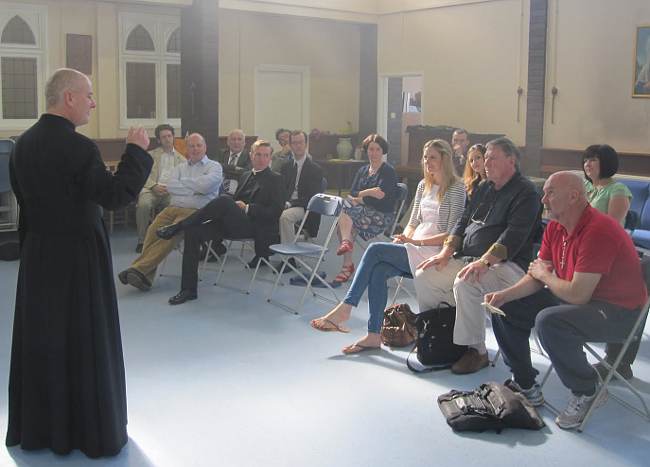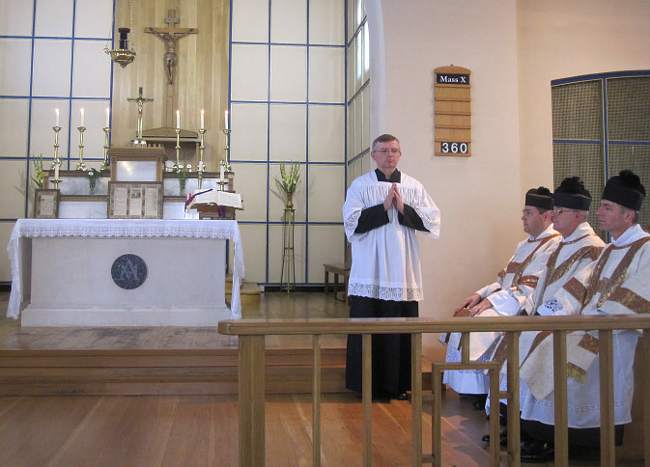For en uke siden startet det en debatt om jente-ministranter, kalt «Save the Altar Girls» – i tidsskiftet America Magazine. Der skriver tidsskriftets redaktører: «Recently Sts. Simon and Jude Cathedral in Phoenix, Ariz., changed its policy on altar servers. From now on only boys may serve; girls may apply for jobs as sacristans. Why? …. These moves to limit laywomen’s access to the altar threaten to drag the church back into the pre-Vatican II world. One wonders if next the altar rail will return, another barrier between the priests and the people. …»
Rektoren i domkirken i Phoenix, Fr. John T. Lankeit, oppledve at tidskriftet hadde vridd alt han hadde fortalt dem om dette, og skrev derfor i en kommentar til artikkelen (# 7 av i alt ca 200 kommentarer) følgende (og hans kommentar sier en hel om debattklimaet):
… As the rector mentioned in this piece, I feel compelled to respond to the distortion and emotionalism contained herein, but the sheer amount of slant makes it tremendously difficult to even know where to start. It seems best for me to being with my exact words to the good assistant editor who contacted me. I told him:
«As the rector, I am the chief liturgist of the parish. I do not, as a general rule, consult our Parish Council on liturgical matters since the typical parish council (and ours, specifically) is not comprised of members formally trained in theology and liturgy. As many in the media have demonstrated clearly, the absence of formal theological and liturgical training leaves far too many individuals evaluating this decision from purely emotional, subjective standpoint. Such decisions require a proper understanding of theological anthropology, sacramental theology and ecclesiology, as well as a willingness to examine honestly what contributes to, and what detracts from, priestly vocations. Naturally, I consulted with the bishop, as he is the canonical pastor of the Cathedral. But he leaves the final decision and implementation to me.»
… To go point-by-point through the article to unmask the distortions would require far more time and effort than I have available to invest, so I’ll highlight just a few of the distortions here:
– “Replacing girls” and “shunting them aside”– if one knows the actual history of altar service, one knows that, prior to the establishment of the seminary system, altar boys were “apprentices” for priesthood, and the service pointed to that specific vocation. It was actually the boys who were replaced at the altar by dissident clergy in the late 80’s and early 90’s prior to the permission being given by the Holy See. So this all started with disobedience which is the epitome of clericalism.
– The “image of the priesthood today”. The obsession with priestly “image” is the problem. The first step in ending the confusion/distortion for this publication’s readers would be for the editor to share Vatican II’s actual teaching on the identity (i.e. Sacramental character) of the priest. That is, unless one dissents from the Church’s theology of priesthood.
– “The policy of John Paul II”. (Could you not, at least, have referred to him as “Blessed” or “Pope”?) Presenting the Holy Father’s clear articulation of the Church’s teaching as a policy is a transparent attempt to frame Church teaching as arbitrary and, therefore, changeable.
….. As food for thought for the readers of America Magazine: If you ever read that an individual featured in an opinion piece like this one responded, “No comment”, please understand that this does not automatically mean the person is afraid to confront a difficult issue. More often than not, such a comment is made out of frustration of having one’s words distorted, truncated or slanted one too many times, as mine were here.
Selv har jeg for øyeblikket ingen planer om å forandre det som nå er vanlig i Norge – at både gutter og jenter ministrarer i vanlige messer – men når jeg bruker den tradisjonelle latinske messen bruker jeg bare gutter/menn.




